Introduction –
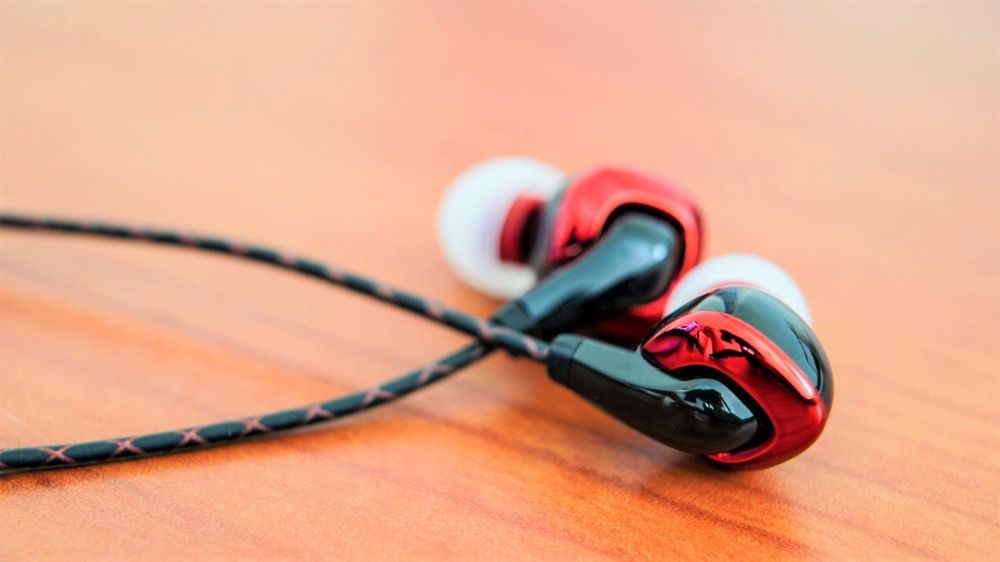
While Fiio recently proved with the X5 III, that they can do great things within the premium market, their original strength as a budget/value orientated brand still remains. Following hot on the heels of the very impressive F1 comes the Fiio F3, a slightly higher end model that retains a similar design language but offers a more stable build and a more exciting sound. Within the hyper-budget earphone foil, Fiio provide two fantastic offerings with their differing sound signatures and fitments suited towards different applications and buyer preferences. One could really own both, and use the more balanced F1 for home usage and the more v-shaped, over-ear F3 for sports and commute. Let’s see what Fiio’s latest earphone has to offer.
Disclaimer –
I would like to thank Fiio very much for providing me with the F3 for review. There is no monetary incentive for a positive review and despite receiving the earphones free of cost, I will be as objective as possible in my evaluation. all statements and opinions in this review are my own.
Accessories –
The F3 comes packaged identically to the F1’s with that same clean white colour scheme and high-contrast renders. The rear has a nice exploded vector in addition to basic specifications. Sliding out the internal tray reveals the earphones within foam and a small box underneath contains the accessories.



Fiio provide the buyer with a very nice faux carbon-fibre carry case. It’s a zippered hard case that is well sized to fit the earphones and a few accesories within but also fit inside a larger jacket pocket. The F3’s come with the same great silicone tips as the F1, they are comfortable yet solid and vastly improved over the flimsy tips that come with most budget earphones. The F3 comes with an additional set of medium tips (as well as small and large sizes) along with earguides to help the conform to an over-ear fit. Fiio aso provide 3 pairs of faceplates that can be swapped like on Westone W-series earphones, they are purely aesthetic and do not touch the sound in any way.

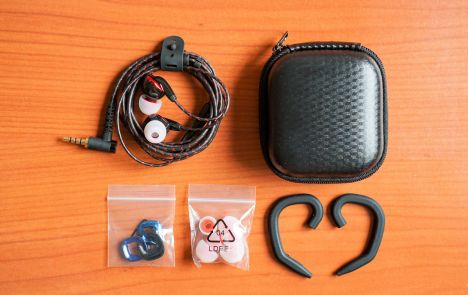

All in all, a nice unboxing that is not overly convoluted but rather effective and clean. The new accessories included with the F3 are thoughtful and functional, they are all of very good quality and its good to see Fiio putting effort into the intricacies as well as the bigger picture.
Design –

The F3’s are designed very much like the F1’s. As a result, they are hardly the most fashionable or professional looking earphones that I have reviewed, but they are relatively sleek and practical where it matters. While the smoked plastic housings admittedly feel pretty cheap, the Xiaomi Pistons easily best the Fiio’s here, they are very lightweight and ergonomically styled; embodying the ethos of function over form.

In this vein, and despite using a considerably larger driver, the F3’s housings actually felt more ergonomic to me than the smaller F1’s; they possess a smoother design that promotes a deeper fitment. Though I had no comfort issues with the F1, the F3 disappears more in my ear over time.

But perhaps the greatest deviation from the design of the F1, is the adoption of an over-ear fitment. This is actually quite a notable feature since over-ear earphones hold many advantages over conventional cable down earphones (such as increased stability and vastly reduced cable noise), but are difficult to find for under ~$60 AUD (there are a few from Meeaudio and Vsonic for around this price but few under it). The $30 AUD F3’s not only carry such a fitment, but are comfortable, isolating and, as I’ll detail in the sound section of this review, sound pretty impressive to boot.
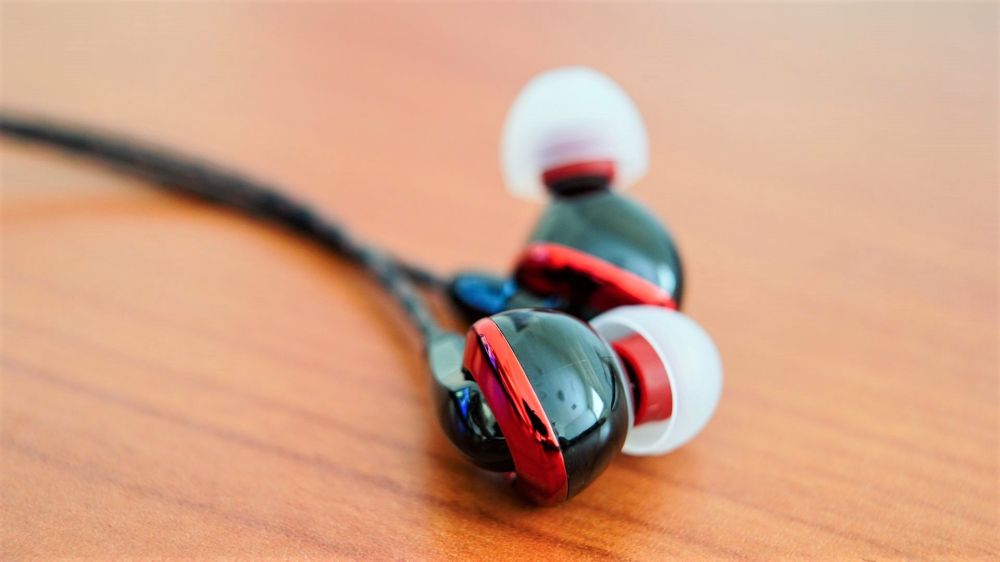
The F3’s are noticeably more stable in the ear than earphones such as the Xiaomi Pistons, they are also far less susceptible to microphonics than any other budget earphone. While I did occasionally find the cable to flick over the top of my ear, the included silicone ear guides do solve this issue entirely. The deeper fitment and sealed design did contribute to a little more isolation than I experienced with the F1, Origem Dual Drivers and Pistons though they still isolate considerably less than higher end monitor style earphones that fill more of the outer ear and have a denser build (such as Westones, Shures, etc). I found isolation with the stock silicone tips to be sufficient for public transport and the fit was solid during my general commute, they fit remarkably well for a budget earphone but still don’t expect Shure level stability.
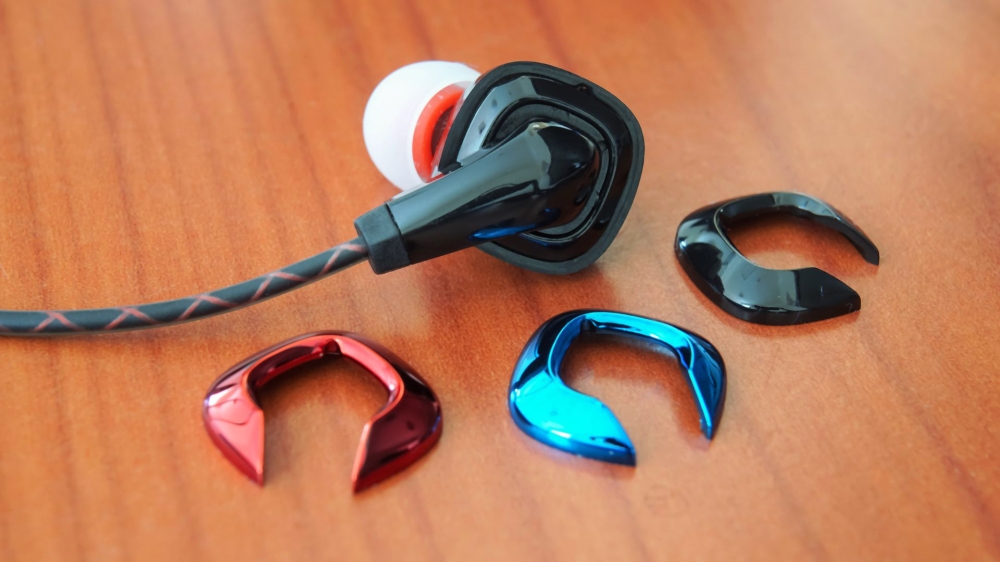
In terms of visual design, Fiio have taken a page out of Westone’s book to add a bit of flair to the design by means of swappable metallic faceplates (option of red, blue and black). This gives users the opportunity to choose a colour they prefer or better differentiate between channels, ie you can use blue for left and red for right. The mechanism is well realised, the plates simple click down into place and slide upwards away from the stem. The colours are also nice and rich, Fiio’s choice of darker red and blue hues does look quite premium though the plain black plates are nice too.
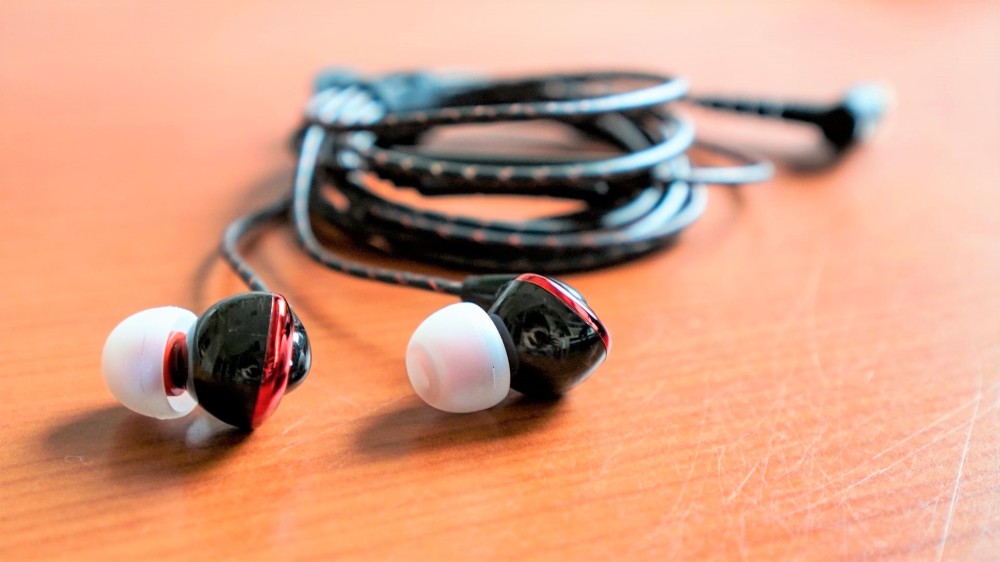
Moving down to the cable, we find the same compliant, strong and tangle-resistant component that was employed on the F1 which is no issue since I found it to be one of the better cables out there. If you haven’t read my F1 review, the cable is supple, smooth and has perfect thickness. The jack is great and all strain reliefs are well above average for a budget earphone.
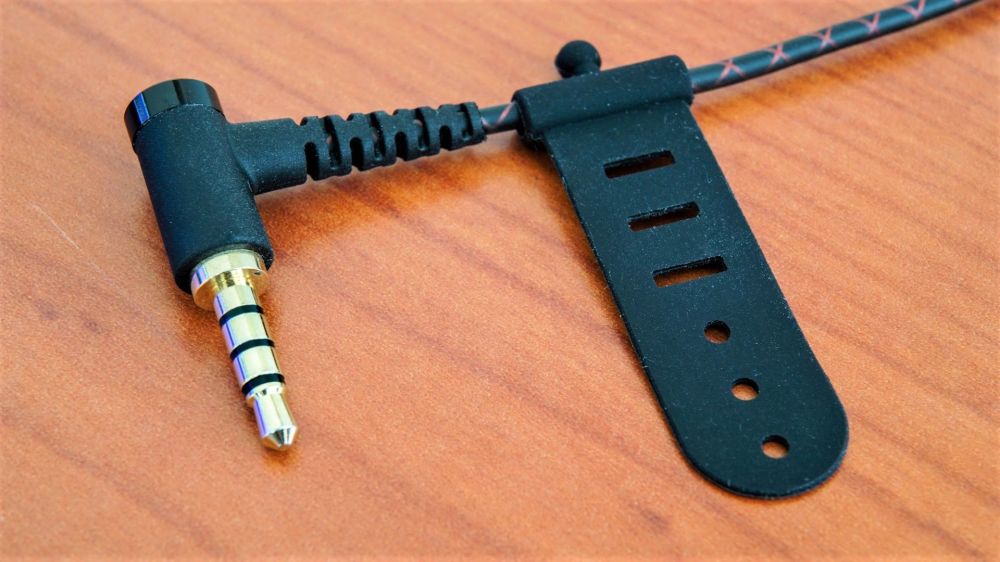
The design has been altered slightly to accommodate for the revised fitment; the cable is slightly longer than that on the F1 and the remote has been moved down so that it is properly placed when worn over the ear. Though, just like how the F1 could comfortably fit cable-down, the F3 can be easily be worn cable down by reversing orientation. The same integrated cable strap makes a return and once again I found it to be a functional and wise addition. One thing that I didn’t note in my F1 review is that the strap is a little loose on the cable and had a tendency to slide up and down along its length. I would suggest fixing the strap in place or at least making it tighter on the cable.
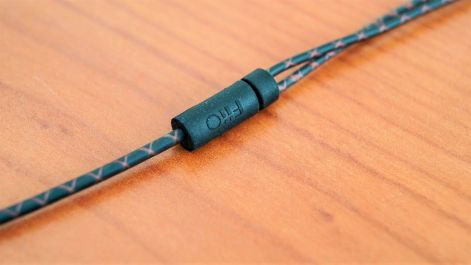

Fiio include the same 3-button remote and mic combo as the F1. The aluminium remote feels nice in the hand, but the plastic buttons still rattle within the housing, diminishing the quality of the earphones. Otherwise, the remote functioned perfectly with my HTC 10 and mic quality was quite good.

So overall, while the housings are similar in quality to the lower end F1 (though the price difference between the two is pretty negligible), the revised shaping/fitment and added features produce an earphone that handles completely differently, in a good way.
Sound –
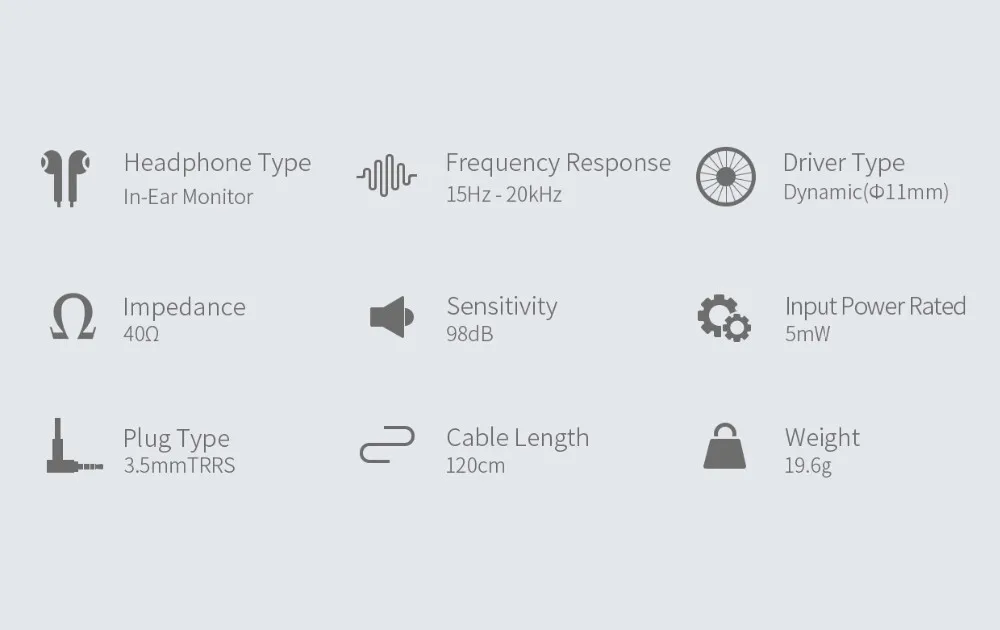
Utilising a slightly larger 11mm driver (vs 9.2mm on the F1) and a slightly better sealing fitment, the F3 does well to address the limited bass extension that I was experiencing with the F1. In addition, the F3 has the more detailed, aggressive sound of the two, altogether producing an earphone that is a nice compliment to the smoother, more balanced F1.
Tonality –
The F3 is the F1’s more exciting counterpart. While the F1 carried a laid-back, rich u-shaped sound, the F3 sports a more engaging v-shaped signature that makes it sound broader and more dynamic in general. Sub-bass has greater extension and emphasis while mid-bass remains similarly punchy. Mids are a little more recessed on the F3 as opposed to the F1 though the F3 is hardly congested with a greater sense of clarity. Treble is slightly emphasised, just less so than the low-end. It’s a more linear boost than the F1 and high notes sound more naturally detailed and less granular.
Soundstage Imaging and separation –
The F3’s provide a pleasing soundstage performance for a budget earphone. Like the F1, they avoid sounding overly intimate and compressed, especially with the F3’s more dynamic sound signature and the F3’s do have more space than the F1’s due to their v-shaped tuning. Listening to BigBang’s “Last Dance” and the F3’s portray a nice sense of both depth and width, similar to the Origems and easily superior to the darker Xiaomi Pistons earphones. The Cure’s “Close to Me” was reproduced with well-placed if not razor sharp imaging similar to the other best in class budget earphones but still behind earphones like the Shozy Zero and Oriveti Basic (understandable since they are more expensive). Separation is very good considering their price tag and upper mids and treble in particular, have a nice sense of separation and air.
Drivability –
Despite their impedance rising to 40ohms from the F1’s 16ohms, the F3’s are similarly sensitive as the rest of the budget earphones I have on hand. They are also pretty easy to drive, I didn’t notice a huge difference listening directly from HTC 10 and amped through my Oppo HA-2 (without using the Saber DAC). As with any decent earphone, they do scale a bit with nicer gear, namely the soundstage increases in size and separation is improved, they also have a little more bass extension from a source like the X5 III over an iPod for example. While they do moderately hiss from my Oppo HA-2, I still would not consider the F3 a difficult earphone to drive and you will be able to squeeze optimal performance from any decent portable source (silent from my 10 and iPod touch 6g).
Bass –
The lower end response sounds more like the Origem Dual Drivers than the F1’s, with a more lower-bass, sub-bass focussed emphasis over the mid-bass focus on the F1’s, but they have a more linear boost overall than either. They actually have quite a lot of bass, but the way Fiio have tuned the F3’s and the quality of that bass response results in a more enjoyable experience than any other budget earphone I’ve heard so far (save for the Xiaomi Hybrid Pro perhaps). Sub-bass extension is really great for a budget earphone, many tend to struggle with extension, but the F3’s deliver impressive amounts of rumble and slam within the lowest registers. The bass drums in Toto’s “Rosanna” were nice and full without sounding slurred while the bassline in The Red Hot Chilli Peppers “Soul to Squeeze” was reproduced with nice texturing that easily bested the F1 and Pistons. Bass is articulate and, despite being reasonably muddy, is warm and lush. They are more textured than both the F1 and Dual Drivers with a more even bass boost that sounds a lot more refined overall.
I really do like the way the F3’s do bass, the F1’s will suit those who prefer a more neutral response, but the F3’s combine a full, natural bass tone with much improved quality. They do have slightly too much low-end for me, especially on tracks that are already quite bassy, but keeping in mind that these cost $30, the F3’s are favourable over the Xiaomi Pistons 2/3, Origem Dual Drivers, Rock Zircon and KZ ATE; they are the most textured, the most linear and also have better extension than all of these models.
Mids –
Mids are slightly recessed in relation to bass and treble but are never overwhelmed. Male vocals are slightly recessed while female vocals are more present but both are a little distant overall. With a slightly brighter midrange tone, clarity and veil are much improved over the F1 though some may prefer the more mid-forward, slightly more balanced F1’s. I did personally find the lower midrange on the F3 generally pleasing, there is a great sense of body and detail to male vocals that the thinner F1 did not capture. That is not to say that lower mids are thick or muddy, they easily sound clearer than the thicker Shure SE215’s for instance, but they are definitely warmer in nature (which is quite normal for a budget earphone). Vocal intelligibility was still very good, though more recessed tracks such as Eric Clapton’s “Layla” did sound a little too distant, and acoustic instruments avoid sounding tubby. Upper mids are slightly more present, piano notes and strings tend to be a little more forward in the mix than male vocals and guitars. They lack that veil of the F1’s and swing more in the opposite direction. Female vocals are clear and well layered, strings and piano notes sound relatively uncoloured and there is a nice sense of clarity to the general midrange.
Highs –
The treble performance on the F3’s is actually really, really impressive for the price. The highs were probably the most surprising aspect of the earphones in that they are so refined. While not refined, smooth or supremely detailed in the grand scheme of things, the F3’s have superior resolution and detail retrieval to the F1’s and Origem’s and are considerably better performers than the Rock Zircon and KZ ATE (though these are a little cheaper). Details are quite forward due to the treble boost, though not quite as aggressive as the Xiaomi Hybrid Pro’s, making for a very engaging, but not fatiguing listen. The clashing cymbals in Elton John’s “Rocketman” were more sparkly than neutral but not particularly splashy or thin and the high-hats, while quite distant and a little rolled-off, sounded natural rather than tizzy. Micro-details were well portrayed and treble is overall a great performer for the price. Since budget earphones often have quite a rolled-off/non-existant treble response, I can see some people preferring the milder F1’s though for my personal preferences, the F3’s are superior, both in quality and tonality; they are considerably less rolled-off up top and provide much more insight into your favourite music as a result.
Verdict –

While the quality of the F3’s sound is superior to the F1 overall, the very similar pricing and revised tuning do make it more of an alternative rather than an outright upgrade. For my personal preferences, and probably the vast majority of buyers in this price range, the F3’s are the better earphone and their engaging and lush yet detailed sound will likely garner plenty of fans. From my knowledge, the most popular models around this price seem to be the Rock Zircon, KZ ATE and Xiaomi Pistons however, the new F3 from Fiio has proven to be quite formidable in direct comparison. Combining a stable over-ear fit, comfortable design and robust build, the F3 has easily become my new budget earphone recommendation for lovers of an engaging sound. While the F1 was slightly worse than the class leaders in terms of SQ but superior in build, the F3 bests these earphones while compounding on the strengths of the F1.
Accessories – 9/10, Nice unboxing similar to the Xiaomi Hybrids and other better budget earphones. Great stock tip quality, silicone ear guides and a nice hard carry case. Faceplate mechanisms are nice for differentiating each side and general aesthetic pleasure.
Design – 9.5/10, Fantastic cable with integrated strap for storage. Inline remote works well though rattling buttons are an issue. Over-ear fitment is comfortable and increases stability during any kind of activity. The housings feel a little hollow, but they are super lightweight for longer usage. Isolation is good for public transport and faceplate swapping adds just a little personalisation.
*Sound ratings are universal and disregard price to allow for comparison
Bass – 6/10, Nicely extended and textured for a budget earphone, but still muddy overall. Relatively linear boost sounds natural and lush, does not overwhelm lower midrange.
Mids – 5.75/10, Slightly brighter, lower midrange can sound distant with some material. Great clarity and detailing in upper midrange.
Treble – 6/10, Well extended but still rolled-off at the very top. Sparkly and very well detailed. Nice sense of body to cymbals and higher strings.
Soundstage, Imaging and Separation – 5.5/10, Good sense of space with nice depth in particular. Upper mids have nice separation though warmer lower mids are slightly congested. Imaging is good, not great.
Verdict – 9/10, The F3’s are perhaps the most tastefully tuned v-shaped budget earphone I’ve come across. They have a nice balance between frequencies and have all the right kinds of emphasis. Quality is also really great and they make for a nice upgrade to any $10-20 earphone. The fitment is class-leading as is build quality. I hate being this overly positive, but the F3 is just a very well-rounded earphone. As such, I believe the Fiio F3 deserves a solid recommendation.
Thanks for reading! If you enjoyed my review, please have a look at my website for more just like it:
https://everydaylisteningblog.wordpress.com/2017/03/11/fiio-f3-review-economical-energetic-engaging/

While Fiio recently proved with the X5 III, that they can do great things within the premium market, their original strength as a budget/value orientated brand still remains. Following hot on the heels of the very impressive F1 comes the Fiio F3, a slightly higher end model that retains a similar design language but offers a more stable build and a more exciting sound. Within the hyper-budget earphone foil, Fiio provide two fantastic offerings with their differing sound signatures and fitments suited towards different applications and buyer preferences. One could really own both, and use the more balanced F1 for home usage and the more v-shaped, over-ear F3 for sports and commute. Let’s see what Fiio’s latest earphone has to offer.
Disclaimer –
I would like to thank Fiio very much for providing me with the F3 for review. There is no monetary incentive for a positive review and despite receiving the earphones free of cost, I will be as objective as possible in my evaluation. all statements and opinions in this review are my own.
Accessories –
The F3 comes packaged identically to the F1’s with that same clean white colour scheme and high-contrast renders. The rear has a nice exploded vector in addition to basic specifications. Sliding out the internal tray reveals the earphones within foam and a small box underneath contains the accessories.



Fiio provide the buyer with a very nice faux carbon-fibre carry case. It’s a zippered hard case that is well sized to fit the earphones and a few accesories within but also fit inside a larger jacket pocket. The F3’s come with the same great silicone tips as the F1, they are comfortable yet solid and vastly improved over the flimsy tips that come with most budget earphones. The F3 comes with an additional set of medium tips (as well as small and large sizes) along with earguides to help the conform to an over-ear fit. Fiio aso provide 3 pairs of faceplates that can be swapped like on Westone W-series earphones, they are purely aesthetic and do not touch the sound in any way.



All in all, a nice unboxing that is not overly convoluted but rather effective and clean. The new accessories included with the F3 are thoughtful and functional, they are all of very good quality and its good to see Fiio putting effort into the intricacies as well as the bigger picture.
Design –

The F3’s are designed very much like the F1’s. As a result, they are hardly the most fashionable or professional looking earphones that I have reviewed, but they are relatively sleek and practical where it matters. While the smoked plastic housings admittedly feel pretty cheap, the Xiaomi Pistons easily best the Fiio’s here, they are very lightweight and ergonomically styled; embodying the ethos of function over form.

In this vein, and despite using a considerably larger driver, the F3’s housings actually felt more ergonomic to me than the smaller F1’s; they possess a smoother design that promotes a deeper fitment. Though I had no comfort issues with the F1, the F3 disappears more in my ear over time.

But perhaps the greatest deviation from the design of the F1, is the adoption of an over-ear fitment. This is actually quite a notable feature since over-ear earphones hold many advantages over conventional cable down earphones (such as increased stability and vastly reduced cable noise), but are difficult to find for under ~$60 AUD (there are a few from Meeaudio and Vsonic for around this price but few under it). The $30 AUD F3’s not only carry such a fitment, but are comfortable, isolating and, as I’ll detail in the sound section of this review, sound pretty impressive to boot.

The F3’s are noticeably more stable in the ear than earphones such as the Xiaomi Pistons, they are also far less susceptible to microphonics than any other budget earphone. While I did occasionally find the cable to flick over the top of my ear, the included silicone ear guides do solve this issue entirely. The deeper fitment and sealed design did contribute to a little more isolation than I experienced with the F1, Origem Dual Drivers and Pistons though they still isolate considerably less than higher end monitor style earphones that fill more of the outer ear and have a denser build (such as Westones, Shures, etc). I found isolation with the stock silicone tips to be sufficient for public transport and the fit was solid during my general commute, they fit remarkably well for a budget earphone but still don’t expect Shure level stability.

In terms of visual design, Fiio have taken a page out of Westone’s book to add a bit of flair to the design by means of swappable metallic faceplates (option of red, blue and black). This gives users the opportunity to choose a colour they prefer or better differentiate between channels, ie you can use blue for left and red for right. The mechanism is well realised, the plates simple click down into place and slide upwards away from the stem. The colours are also nice and rich, Fiio’s choice of darker red and blue hues does look quite premium though the plain black plates are nice too.

Moving down to the cable, we find the same compliant, strong and tangle-resistant component that was employed on the F1 which is no issue since I found it to be one of the better cables out there. If you haven’t read my F1 review, the cable is supple, smooth and has perfect thickness. The jack is great and all strain reliefs are well above average for a budget earphone.

The design has been altered slightly to accommodate for the revised fitment; the cable is slightly longer than that on the F1 and the remote has been moved down so that it is properly placed when worn over the ear. Though, just like how the F1 could comfortably fit cable-down, the F3 can be easily be worn cable down by reversing orientation. The same integrated cable strap makes a return and once again I found it to be a functional and wise addition. One thing that I didn’t note in my F1 review is that the strap is a little loose on the cable and had a tendency to slide up and down along its length. I would suggest fixing the strap in place or at least making it tighter on the cable.


Fiio include the same 3-button remote and mic combo as the F1. The aluminium remote feels nice in the hand, but the plastic buttons still rattle within the housing, diminishing the quality of the earphones. Otherwise, the remote functioned perfectly with my HTC 10 and mic quality was quite good.

So overall, while the housings are similar in quality to the lower end F1 (though the price difference between the two is pretty negligible), the revised shaping/fitment and added features produce an earphone that handles completely differently, in a good way.
Sound –

Utilising a slightly larger 11mm driver (vs 9.2mm on the F1) and a slightly better sealing fitment, the F3 does well to address the limited bass extension that I was experiencing with the F1. In addition, the F3 has the more detailed, aggressive sound of the two, altogether producing an earphone that is a nice compliment to the smoother, more balanced F1.
Tonality –
The F3 is the F1’s more exciting counterpart. While the F1 carried a laid-back, rich u-shaped sound, the F3 sports a more engaging v-shaped signature that makes it sound broader and more dynamic in general. Sub-bass has greater extension and emphasis while mid-bass remains similarly punchy. Mids are a little more recessed on the F3 as opposed to the F1 though the F3 is hardly congested with a greater sense of clarity. Treble is slightly emphasised, just less so than the low-end. It’s a more linear boost than the F1 and high notes sound more naturally detailed and less granular.
Soundstage Imaging and separation –
The F3’s provide a pleasing soundstage performance for a budget earphone. Like the F1, they avoid sounding overly intimate and compressed, especially with the F3’s more dynamic sound signature and the F3’s do have more space than the F1’s due to their v-shaped tuning. Listening to BigBang’s “Last Dance” and the F3’s portray a nice sense of both depth and width, similar to the Origems and easily superior to the darker Xiaomi Pistons earphones. The Cure’s “Close to Me” was reproduced with well-placed if not razor sharp imaging similar to the other best in class budget earphones but still behind earphones like the Shozy Zero and Oriveti Basic (understandable since they are more expensive). Separation is very good considering their price tag and upper mids and treble in particular, have a nice sense of separation and air.
Drivability –
Despite their impedance rising to 40ohms from the F1’s 16ohms, the F3’s are similarly sensitive as the rest of the budget earphones I have on hand. They are also pretty easy to drive, I didn’t notice a huge difference listening directly from HTC 10 and amped through my Oppo HA-2 (without using the Saber DAC). As with any decent earphone, they do scale a bit with nicer gear, namely the soundstage increases in size and separation is improved, they also have a little more bass extension from a source like the X5 III over an iPod for example. While they do moderately hiss from my Oppo HA-2, I still would not consider the F3 a difficult earphone to drive and you will be able to squeeze optimal performance from any decent portable source (silent from my 10 and iPod touch 6g).
Bass –
The lower end response sounds more like the Origem Dual Drivers than the F1’s, with a more lower-bass, sub-bass focussed emphasis over the mid-bass focus on the F1’s, but they have a more linear boost overall than either. They actually have quite a lot of bass, but the way Fiio have tuned the F3’s and the quality of that bass response results in a more enjoyable experience than any other budget earphone I’ve heard so far (save for the Xiaomi Hybrid Pro perhaps). Sub-bass extension is really great for a budget earphone, many tend to struggle with extension, but the F3’s deliver impressive amounts of rumble and slam within the lowest registers. The bass drums in Toto’s “Rosanna” were nice and full without sounding slurred while the bassline in The Red Hot Chilli Peppers “Soul to Squeeze” was reproduced with nice texturing that easily bested the F1 and Pistons. Bass is articulate and, despite being reasonably muddy, is warm and lush. They are more textured than both the F1 and Dual Drivers with a more even bass boost that sounds a lot more refined overall.
I really do like the way the F3’s do bass, the F1’s will suit those who prefer a more neutral response, but the F3’s combine a full, natural bass tone with much improved quality. They do have slightly too much low-end for me, especially on tracks that are already quite bassy, but keeping in mind that these cost $30, the F3’s are favourable over the Xiaomi Pistons 2/3, Origem Dual Drivers, Rock Zircon and KZ ATE; they are the most textured, the most linear and also have better extension than all of these models.
Mids –
Mids are slightly recessed in relation to bass and treble but are never overwhelmed. Male vocals are slightly recessed while female vocals are more present but both are a little distant overall. With a slightly brighter midrange tone, clarity and veil are much improved over the F1 though some may prefer the more mid-forward, slightly more balanced F1’s. I did personally find the lower midrange on the F3 generally pleasing, there is a great sense of body and detail to male vocals that the thinner F1 did not capture. That is not to say that lower mids are thick or muddy, they easily sound clearer than the thicker Shure SE215’s for instance, but they are definitely warmer in nature (which is quite normal for a budget earphone). Vocal intelligibility was still very good, though more recessed tracks such as Eric Clapton’s “Layla” did sound a little too distant, and acoustic instruments avoid sounding tubby. Upper mids are slightly more present, piano notes and strings tend to be a little more forward in the mix than male vocals and guitars. They lack that veil of the F1’s and swing more in the opposite direction. Female vocals are clear and well layered, strings and piano notes sound relatively uncoloured and there is a nice sense of clarity to the general midrange.
Highs –
The treble performance on the F3’s is actually really, really impressive for the price. The highs were probably the most surprising aspect of the earphones in that they are so refined. While not refined, smooth or supremely detailed in the grand scheme of things, the F3’s have superior resolution and detail retrieval to the F1’s and Origem’s and are considerably better performers than the Rock Zircon and KZ ATE (though these are a little cheaper). Details are quite forward due to the treble boost, though not quite as aggressive as the Xiaomi Hybrid Pro’s, making for a very engaging, but not fatiguing listen. The clashing cymbals in Elton John’s “Rocketman” were more sparkly than neutral but not particularly splashy or thin and the high-hats, while quite distant and a little rolled-off, sounded natural rather than tizzy. Micro-details were well portrayed and treble is overall a great performer for the price. Since budget earphones often have quite a rolled-off/non-existant treble response, I can see some people preferring the milder F1’s though for my personal preferences, the F3’s are superior, both in quality and tonality; they are considerably less rolled-off up top and provide much more insight into your favourite music as a result.
Verdict –

While the quality of the F3’s sound is superior to the F1 overall, the very similar pricing and revised tuning do make it more of an alternative rather than an outright upgrade. For my personal preferences, and probably the vast majority of buyers in this price range, the F3’s are the better earphone and their engaging and lush yet detailed sound will likely garner plenty of fans. From my knowledge, the most popular models around this price seem to be the Rock Zircon, KZ ATE and Xiaomi Pistons however, the new F3 from Fiio has proven to be quite formidable in direct comparison. Combining a stable over-ear fit, comfortable design and robust build, the F3 has easily become my new budget earphone recommendation for lovers of an engaging sound. While the F1 was slightly worse than the class leaders in terms of SQ but superior in build, the F3 bests these earphones while compounding on the strengths of the F1.
Accessories – 9/10, Nice unboxing similar to the Xiaomi Hybrids and other better budget earphones. Great stock tip quality, silicone ear guides and a nice hard carry case. Faceplate mechanisms are nice for differentiating each side and general aesthetic pleasure.
Design – 9.5/10, Fantastic cable with integrated strap for storage. Inline remote works well though rattling buttons are an issue. Over-ear fitment is comfortable and increases stability during any kind of activity. The housings feel a little hollow, but they are super lightweight for longer usage. Isolation is good for public transport and faceplate swapping adds just a little personalisation.
*Sound ratings are universal and disregard price to allow for comparison
Bass – 6/10, Nicely extended and textured for a budget earphone, but still muddy overall. Relatively linear boost sounds natural and lush, does not overwhelm lower midrange.
Mids – 5.75/10, Slightly brighter, lower midrange can sound distant with some material. Great clarity and detailing in upper midrange.
Treble – 6/10, Well extended but still rolled-off at the very top. Sparkly and very well detailed. Nice sense of body to cymbals and higher strings.
Soundstage, Imaging and Separation – 5.5/10, Good sense of space with nice depth in particular. Upper mids have nice separation though warmer lower mids are slightly congested. Imaging is good, not great.
Verdict – 9/10, The F3’s are perhaps the most tastefully tuned v-shaped budget earphone I’ve come across. They have a nice balance between frequencies and have all the right kinds of emphasis. Quality is also really great and they make for a nice upgrade to any $10-20 earphone. The fitment is class-leading as is build quality. I hate being this overly positive, but the F3 is just a very well-rounded earphone. As such, I believe the Fiio F3 deserves a solid recommendation.
Thanks for reading! If you enjoyed my review, please have a look at my website for more just like it:
https://everydaylisteningblog.wordpress.com/2017/03/11/fiio-f3-review-economical-energetic-engaging/



































